Does sourdough starter get better with age?
Bakers boast about starter that’s years — decades! — old. But does the age of your starter actually impact your baking?
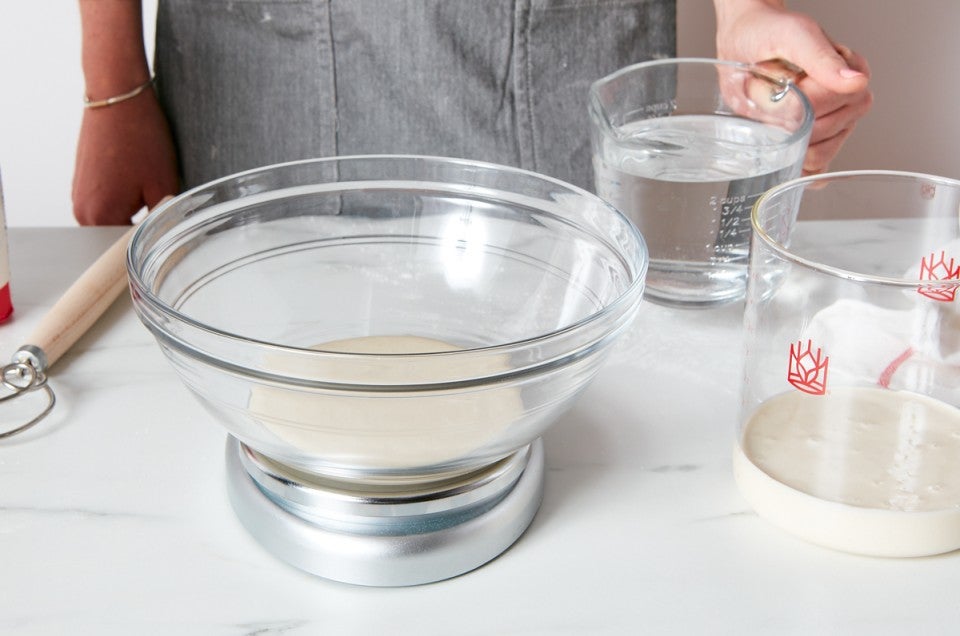

Bakers often liken their sourdough starter to a pet. They give it a cute name (“Doughy Parton”), express slight exasperation about feeding schedules, and brag about a bond strengthened by time.
Having a sourdough starter that’s years — sometimes decades! — old instills a sense of accomplishment and pride, and some bakers love to share their starter origin stories. But does an older starter actually make better bread?
For most bakers, the answer is a clear no.
Maurizio Leo, author of the award-winning bread cookbook The Perfect Loaf, still uses the first starter he ever made; it’s now 12 years old. And while he’s sentimental about that starter, he says its age doesn't really impact his bread. Flour Power author Tara Jensen agrees; she emphasizes that your starter’s health is more important than its age. “When it comes down to the performance of the starter in a dough, I’d rather use a starter that’s a few weeks old and been well kept than an older starter that’s been neglected,” she says.
King Arthur baker Martin Philip puts it more bluntly: “Starter age is unimportant to me.” He adds, “Once the starter reaches a state of relative stasis and reliability, I don’t care if it’s eight or 80. I just want to make stuff with it.”
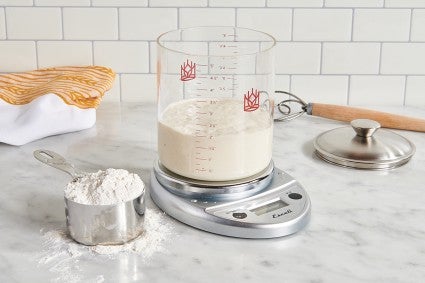
It’s worth taking a closer look at sourdough starter itself and how it evolves over time. It’s a bit like the Ship of Theseus, the philosophical thought experiment that asks whether an object is technically the same object after having all its original components replaced. The same principle is at play in sourdough starter — because starter is continually replaced with new doses of flour and water to feed the flourishing community of microbes that it contains, it doesn’t stay stagnant. Instead, “starters tend to evolve along with you and your feeding practices,” explains Baker’s Hotline member and sourdough specialist Barb Alpern.
As Jennifer Latham, author of Bread Baking with Kids and former lead bread baker at Tartine, recounts, “At Tartine I was taught that the age or origin of your starter didn’t really matter because it would always adjust to the conditions it was being fed in.” So basically, if you have a starter that’s ten years old, it doesn’t matter what it was like a decade ago, or even a few years ago. What’s going to impact your bread the most is how your starter thrives in the conditions it’s currently in (and of course, how well you’re feeding and maintaining it).
That doesn’t mean you can’t preserve certain characteristics of a starter, though. Jennifer recounts how Thomas Teffri-Chambelland, a former microbiologist and author of Sourdough Panettone and Viennoiserie, gifted her a starter that contained a specific microbe required for panettone dough (which needs a specialized environment because it’s high in fat and sugar and low in water). He told her that as long as she fed it with the right regimen of very dry feedings and sugar water baths, she could retain this microbe in her starter by sustaining an environment in which it thrives and has an advantage over most other flora that might be introduced. Jennifer theorizes that “if you collect a certain microbe and keep it alive through feeding, it probably won’t die out just because new microbes are introduced.” As she mused, “I wonder if some of the anecdotal evidence of older starters having better flavor or baking capabilities comes from a greater biodiversity in them.”
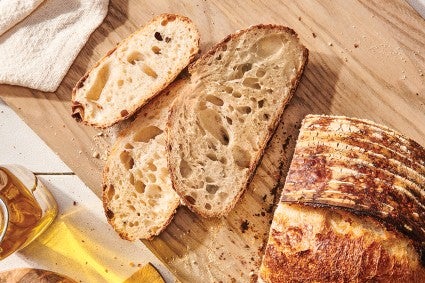
Jennifer likes to expose her starter to new environments in the hopes of introducing “something new and fun,” as she puts it. She travels with her starter and always leaves the lid cracked in new locations, from Big Sur to Sebastopol, California, to allow new microbes to wander in. Maurizio does something similar: “Over the years, I’ve integrated bits of other bakers’ starters from around the world into mine. It’s a way to introduce new microbes, speed evolution, and get the strongest starter possible!”
This approach reflects the deeply personal relationship many bakers have with their starter — just like they do with their pet. “My starter has been with me through countless bakes and many life changes,” Maurizio reminisces. Tara adds, “I think origin stories are important, and often the narratives we tell about the age of our starters involve other stories about family, friends, and places we love. … It’s a beautiful thing for something to be tended to for 20, 50, 100 years.”
Here at King Arthur, our Classic Fresh Sourdough Starter is descended from one that’s been lovingly nurtured in New England for decades. Once you feed and maintain it in your own home, it will eventually adapt to your own region and climate, becoming uniquely yours. At the same time, though, you can know that thousands of bakers before you — including many of us at King Arthur! — have made wonderful sourdough bread with a bit of this same starter.
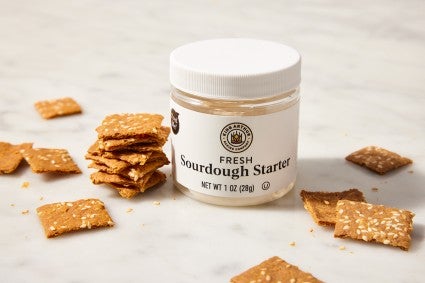
While the age of your starter won’t make your bread any better — turns out, only good sourdough practices can do that — it’s a link in the long legacy of sourdough, one of the oldest forms of baking that exists. Whether your starter is a week or a decade old, you can become part of that lineage as well.
Get baking with more essential sourdough knowledge:
Cover photo by Rick Holbrook; food styling by Kaitlin Wayne.
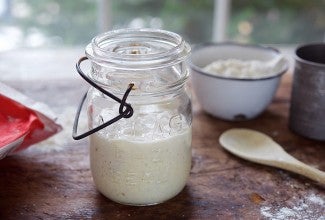


April 16, 2024 at 9:30am
My sourdough journey began at a KA class almost 10 years ago and I haven’t looked back since. The 50 grams of starter given to me at the end of class has been my pride and joy!!!
Each time I bake I marvel at the evolution of what just a small amount of starter can become.
April 16, 2024 at 3:46pm
In reply to My sourdough journey began… by Anna (not verified)
Thanks for baking with us, Anna!
April 14, 2024 at 1:02pm
I mixed up a new starter about 3 weeks ago. I’ve been feeding it twice a day and keeping it in a Brod & Taylor temp controlled keeper (72F). I’ve made two loaves of Pain de Campagne which turned out beautifully. Then for some unknown reason my starter began to thin out. Not sure what’s happened but I started to feed it 100g of water to 113g of flour to try to bulk up the consistency. Any ideas of what’s happened? What should the consistancy of sourdough starter be? Mine was thick enough at the beginning to scoop it out of its container, now it’s pourable.
April 14, 2024 at 3:23pm
In reply to I mixed up a new starter… by Nancy (not verified)
Hi Nancy, first let me confirm that you're currently feeding your starter with our maintenance routine. Different feeding routines can result in different consistencies, so if you are feeding your starter with more water than flour (by weight) this could result in a thinner consistency.
If you have been feeding your starter with our recommended method (1:1:1, by weight), it could be that your starter is rising more rapidly and starting to fall in between feedings, which tends to result in a thinner consistency. This is because as the starter ferments and become more acidic, the gluten structure gradually begins to break down. Are you also noticing more frothy bubbles on the surface of the starter when you go to feed it? As the starter begins to fall from its peak rise, and the structure of the starter begins to thin out, the bubbles that have been held in place (which is what allows the starter to rise) begin to gravitate to the surface.
Ideally, when you're storing your starter at "room temperature" you want your twice daily feedings to line up close to that peak rise, which not only keeps the starter a bit thicker in consistency, but also allows the yeast to stay more active and vigorous. Rather than adding another feeding to your daily routine (which gets a little nuts), another option would be to keep your starter in a cooler spot, which will help slow things down a bit.
If you still find your starter is rising and falling too rapidly and your starter is continuing to be thinner in consistency, you could also try offering your starter a relatively larger meal. This won't hurt your starter at all but can slow down the ripening process and allow your feedings to line up closer to the peak. For example, rather than feeding with our usual 113g each of starter, water and flour, you might try a 1:4:4 feeding, which would look like this: 28g starter + 113g water + 113g flour.
April 14, 2024 at 10:38am
My starter is said to have originated 150 years ago with the man who founded Guerneville California. The best part about it is that my son traded some beer for it so he could give it to me as a gift. I love feeling connected to Western settlers every time I use it.
April 14, 2024 at 11:51am
In reply to My starter is said to have… by Abby Arnold (not verified)
What a cool story, Abby! Thanks for sharing it with us!
April 10, 2024 at 11:11am
When your starter is returned to the refrigerator, Do you seal the lid, or should you leave it slightly ajar for air to enter? Thanks.
April 11, 2024 at 4:28pm
In reply to When your starter is… by Judy (not verified)
It is best to leave the lid unlocked so that it can off gas as it ferments over time, Judy. It can actually pressurize a bit if you seal it too tightly.
April 14, 2024 at 12:35pm
In reply to It is best to leave the lid… by mperry
Can you clarify what you mean by “locked down”? my starter is completely covered in the refrigerator, but the cover doesn’t have a lock. Should the cover actually be ajar so it’s exposed to the air or is the fact that it’s not locked down allow sufficient air in?
April 14, 2024 at 2:21pm
In reply to Can you clarify what you… by Allison D (not verified)
Hi Allison, how to cover your sourdough starter properly can be a confusing subject. The reason we say to "cover loosely" isn't because the starter needs airflow in order to ferment properly (it doesn't), but because a tightly lidded container can cause fermentation gases to build up in the jar, and sometimes you might even seem the lid pop off. However, when you store your starter in the refrigerator the fermentation activity slows down and as long as you have room above the starter level for the gases to accumulate, it's generally fine to put the lid on securely. Even at room temperature, it's important to cover the starter well enough so that the surface of the starter doesn't dry out, so covering with plastic wrap (which will flex) or a loose lid is preferable to covering it with a cloth.
Pagination